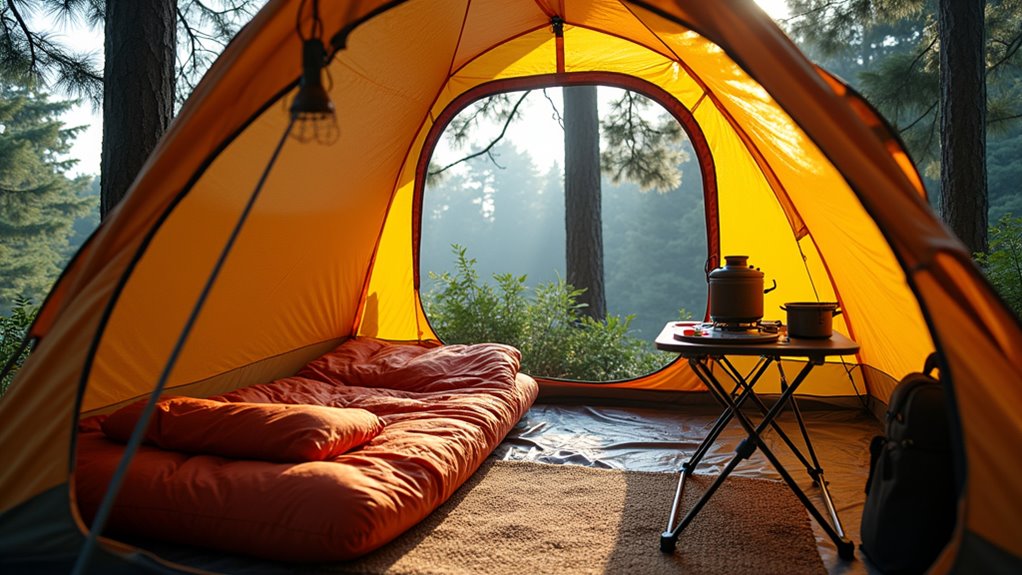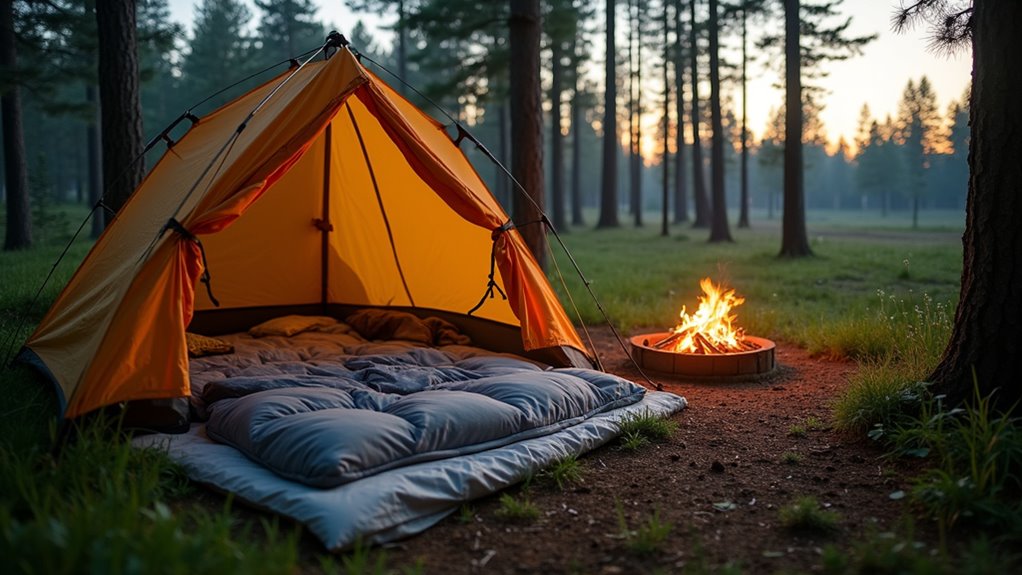What To Put Under Tent
This post contains affiliate links. As an Amazon Associate, we earn from qualifying purchases.
To properly set up your tent, place a waterproof tarp or a tent footprint underneath to block moisture and protect the tent floor. In dry conditions, a canvas tarp can also be used to reduce noise. Additionally, use strong stakes, guylines, and a mallet to ensure stability. These essentials create a comfortable and secure campsite. Further details and tips on enhancing your setup are provided below for those interested in learning more.
Essential Facts in 30 Seconds
- Use a waterproof tarp to keep your tent dry and block ground moisture.
- A tent footprint offers lightweight protection and prevents floor damage.
- Old blankets or carpets add warmth and comfort under the tent.
- Clear and level the ground before pitching the tent for stability.
- Canvas tarps reduce noise and resist tears, ideal for dry weather camping.
Ground Cover Options
Setting up a tent needs the right ground cover. Waterproof tarps block moisture and keep your tent dry. They’re strong and made from polyethylene. Good for car camping but heavy for backpackers. Additionally, using a tarp can improve waterproof ratings by providing an extra layer of protection against ground moisture.
Canvas tarps cut down noise and resist tears. They work best in dry weather. Tent footprints fit your tent perfectly. They’re light and stop wear and tear. Backpackers like them for saving pack weight.
Tyvek is light, stops water, and protects from scrapes. Polycro weighs less but breaks easier. Old blankets or indoor/outdoor carpets add warmth and comfort. These also protect your tent floor well. Using a tarp under your tent provides protection from damage and enhances the longevity of your camping gear.
Choose the ground cover that fits your trip and camping style.
Essential Tent Setup Accessories

Setting up your tent goes easier with the right tools. A mallet helps drive stakes into the ground firmly. A multi-tool fixes small problems fast. Use extra stakes and guy lines to keep your tent strong against wind and rain. Additionally, ensure that you selecting stakes suitable for your terrain type to enhance stability. These simple steps make your camping safer and more comfortable. Remember, the correct usage of tent pegs is crucial for ensuring stability and safety during camping.
Ground Cover Options
The right ground cover protects your tent floor and makes camping better.
Polyurethane-coated nylon or polyester offers strong, waterproof protection. Silnylon feels soft but can tear easily. Cuben fiber is very light and waterproof but breaks fast. Tyvek lasts long and resists water but weighs more. Polycryos suit ultralight campers but wear out quickly. A quality tent footprint is an essential addition to your gear, providing extra protection against ground debris.
Pick a cover slightly smaller than your tent to stop water from collecting. Custom footprints fit perfectly. Grommets or taped corners keep covers in place. Using a footprint can also prolong the lifespan of the tent, ensuring it remains functional for many camping trips.
Choose smart, camp strong.
Securing Your Tent
Securing your tent is key to a good camping trip.
Use strong stakes made from aircraft-grade aluminum for light weight or steel for hard, rocky soil. A rubber mallet helps push stakes into the ground without bending them. Most tents include stakes, but it’s crucial to check if yours does before heading out.
Attach guylines to keep your tent steady in wind or on uneven ground. Use a measuring tape to space stakes properly. This keeps your tent stable and safe. It’s also important to ensure the tent fabric is taut to prevent water pooling during rain.
Strong stakes and careful setup protect you from bad weather. Stay safe and enjoy your time outdoors.
Enhancing Sleeping Comfort

Here is a quick guide to sleeping pads and bags:
| Type | Pros |
|---|---|
| Air pads | Light and easy to carry |
| Closed-cell foam pads | Strong and work in many spots |
| Self-inflating pads | Soft and keep you warm |
| Synthetic sleeping bags | Dry fast and resist water |
Wear clean, dry clothes to stay warm and clean. These simple tips make camping sleep better. Additionally, using a sleeping pad or air mattress can significantly enhance your comfort while resting. To maximize warmth, consider using a closed-cell foam pad for ground insulation.
Lighting and Safety Tools
Camping becomes safer and more fun with the right lighting and safety tools. Good lights help you see well and create a cozy campsite. Use these key tools:
- Headlamps let you use both hands and move easily.
- Lanterns shine light all around your tent and camp.
- Flashlights work as small, easy-to-carry lights. Bring extra batteries.
- Citronella candles give light and keep bugs away.
Safety matters a lot. Always bring a fire extinguisher made for outdoor fires. Keep a bucket of water or sand close for quick fire control.
Place lights on steady surfaces, away from anything that can catch fire. Check all your gear before the trip to make sure it works well.
These steps keep you safe and make camping better.
Cooking and Food Storage Solutions
Efficient cooking and food storage make camping easier and safer. Use clear plastic bins with tight lids to organize food. It helps you find items fast. A big bin for all food saves trips to the cooking area. Keep pots, utensils, and plates in separate bins. This keeps things clean and organized.
Store food in bear-safe containers like metal boxes or locked coolers. These protect your food from animals. If metal boxes aren’t available, hang food bags or use bear canisters. Clean storage bins often to avoid attracting wildlife.
Collapsible buckets work great for washing dishes and keeping the campsite neat. Plan how much food to bring. Avoid too much leftover food and spoilage. These tips make camping cooking and storage simple and safe.
Campsite Comfort Additions
Comfort at your campsite matters a lot. Lightweight, foldable camping chairs offer great comfort for meals and rest.
Portable tables give you a solid place to prepare and eat food. Portable dish racks keep your kitchen gear neat and clean.
Citronella candles and bug spray fight annoying insects. These tools help you enjoy the outdoors without bugs bothering you.
Simple gear changes can make your camping trip much better.
Comfortable Seating Options
Comfortable seating makes camping much better. After hiking, you want a seat that feels good.
Try these options for comfort and ease:
- Portable cushions like the Therm-a-Rest Z-Seat Pad are light and keep you warm.
- Ergonomic chairs such as the REI Flexlite Air support your back and stay steady.
- Folding benches fit groups well and provide extra space without being heavy.
- Sit pads are small, easy to carry, and can also support your back.
Pick seats that are light and easy to carry. Good seating fits your gear and helps you relax.
Camping feels nicer with the right chair or cushion.
Convenient Dining Solutions
Camping meals become easier with the right dining solutions. Durable tables make meal prep simple and fun. Folding tables with waterproof tops and light aluminum frames move easily. Adjustable-height tables fit many cooking styles. Tables with built-in storage keep utensils handy and neat.
Good lighting improves your dining moments. LED string lights add a warm, cozy glow. Battery-powered lanterns shine bright and last long. Clip-on tent lights focus on your food and prep area. Solar lights save energy and work well in daylight. Headlamps free your hands while you cook or eat.
| Dining Surfaces | Lighting Solutions |
|---|---|
| Folding tables | LED string lights |
| Waterproof camp tables | Battery-operated lanterns |
| Adjustable-height tables | Clip-on tent lights |
| Integrated storage tables | Solar-powered lights |
| Lightweight aluminum frames | Headlamps |
Insect Control Measures
Enjoy dining outdoors without bugs ruining your fun.
Keep insects away with smart control steps. Use a mosquito net over your eating area to block bugs.
Spray your tent and clothes with permethrin for long-lasting protection. Light citronella candles around camp to naturally chase insects.
Spray permethrin on the ground around your spot to keep a three-foot bug-free zone.
These easy methods help you relax and enjoy your meal outside.
Frequently Asked Questions
Can I Use a Tarp as a Ground Cover?
A tarp works well as a ground cover. It keeps moisture away and adds a soft layer under you. Tarps are strong and easy to clean. Many campers use tarps to protect their tents from dirt and water. You can also try a ground cloth or a tent footprint. These tools give similar protection and comfort. Using any of these helps keep your gear dry and lasts longer.
How Do I Clean a Tent After Camping?
Cleaning your tent after camping helps it last longer. First, rinse your tent well with clean water. Use mild soap if needed, but avoid harsh chemicals. Gently scrub dirt spots with a soft cloth. Let your tent dry completely in the shade to stop mold. Store it dry and folded loosely to keep fabric strong. Taking care of your tent means many safe and fun trips ahead!
What Materials Are Best for Tent Ground Covers?
Durable ground covers keep tents dry and safe. Tyvek stands out for strength and water resistance. Dyneema Composite Fabric offers lightweight yet tough protection. Polyurethane-coated fabrics block moisture and resist tears. These materials stop dampness, dirt, and bugs from entering. They also add insulation against cold ground. Using strong ground covers helps tents last longer outdoors. Choose one that fits your camping needs and weather conditions.
Should I Use a Footprint or Ground Cover?
A footprint offers a precise fit and lasts longer, especially on rough ground. It saves weight and stops water from seeping in. Ground covers work well for many uses but often weigh more. For camping, a footprint usually works best. It protects your tent floor and keeps you dry. Simple, strong, and light. Just right for your outdoor trips.
How Do I Prevent Moisture Under My Tent?
Stop moisture under your tent by using a groundsheet or footprint. These barriers block wetness from the earth. Keep your tent vents open to let air flow. Good airflow stops condensation inside. Store your clothes and gear in dry bags or plastic containers. Avoid placing your tent on low ground or near water. A little care keeps your tent dry and cozy all night.
Conclusion
Setting up a tent well means thinking about what goes under it. Use a heavy-duty tarp to protect the tent floor from rocks and wet ground. This tarp stops water from soaking through and keeps the tent clean. Add a sleeping pad or inflatable mattress for comfort and insulation from cold ground. Sarah, a camper, used both a tarp and an inflatable sleeping pad on her trip. She said it made her sleep much better. These simple steps help keep you safe and cozy. A good setup makes camping more fun and relaxing.
